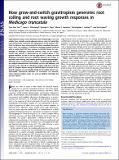| dc.contributor.author | Tan, Tzer Han | |
| dc.contributor.author | Silverberg, Jesse L. | |
| dc.contributor.author | Floss, Daniela S. | |
| dc.contributor.author | Harrison, Maria J. | |
| dc.contributor.author | Henley, Christopher L. | |
| dc.contributor.author | Cohen, Itai | |
| dc.date.accessioned | 2016-05-04T14:09:37Z | |
| dc.date.available | 2016-05-04T14:09:37Z | |
| dc.date.issued | 2015-10 | |
| dc.date.submitted | 2015-05 | |
| dc.identifier.issn | 0027-8424 | |
| dc.identifier.issn | 1091-6490 | |
| dc.identifier.uri | http://hdl.handle.net/1721.1/102392 | |
| dc.description.abstract | Experimental studies show that plant root morphologies can vary widely from straight gravity-aligned primary roots to fractal-like root architectures. However, the opaqueness of soil makes it difficult to observe how environmental factors modulate these patterns. Here, we combine a transparent hydrogel growth medium with a custom built 3D laser scanner to directly image the morphology of Medicago truncatula primary roots. In our experiments, root growth is obstructed by an inclined plane in the growth medium. As the tilt of this rigid barrier is varied, we find Medicago transitions between randomly directed root coiling, sinusoidal root waving, and normal gravity-aligned morphologies. Although these root phenotypes appear morphologically distinct, our analysis demonstrates the divisions are less well defined, and instead, can be viewed as a 2D biased random walk that seeks the path of steepest decent along the inclined plane. Features of this growth response are remarkably similar to the widely known run-and-tumble chemotactic behavior of Escherichia coli bacteria, where biased random walks are used as optimal strategies for nutrient uptake. | en_US |
| dc.description.sponsorship | Cornell University. Engineering Learning Initiative | en_US |
| dc.language.iso | en_US | |
| dc.publisher | National Academy of Sciences (U.S.) | en_US |
| dc.relation.isversionof | http://dx.doi.org/10.1073/pnas.1509942112 | en_US |
| dc.rights | Article is made available in accordance with the publisher's policy and may be subject to US copyright law. Please refer to the publisher's site for terms of use. | en_US |
| dc.source | National Academy of Sciences (U.S.) | en_US |
| dc.title | How grow-and-switch gravitropism generates root coiling and root waving growth responses in Medicago truncatula | en_US |
| dc.type | Article | en_US |
| dc.identifier.citation | Tan, Tzer Han, Jesse L. Silverberg, Daniela S. Floss, Maria J. Harrison, Christopher L. Henley, and Itai Cohen. “How Grow-and-Switch Gravitropism Generates Root Coiling and Root Waving Growth Responses in Medicago Truncatula.” Proc Natl Acad Sci USA 112, no. 42 (October 2, 2015): 12938–12943. | en_US |
| dc.contributor.department | Massachusetts Institute of Technology. Department of Physics | en_US |
| dc.contributor.mitauthor | Tan, Tzer Han | en_US |
| dc.relation.journal | Proceedings of the National Academy of Sciences | en_US |
| dc.eprint.version | Final published version | en_US |
| dc.type.uri | http://purl.org/eprint/type/JournalArticle | en_US |
| eprint.status | http://purl.org/eprint/status/PeerReviewed | en_US |
| dspace.orderedauthors | Tan, Tzer Han; Silverberg, Jesse L.; Floss, Daniela S.; Harrison, Maria J.; Henley, Christopher L.; Cohen, Itai | en_US |
| dc.identifier.orcid | https://orcid.org/0000-0001-6246-882X | |
| mit.license | PUBLISHER_POLICY | en_US |
| mit.metadata.status | Complete | |
